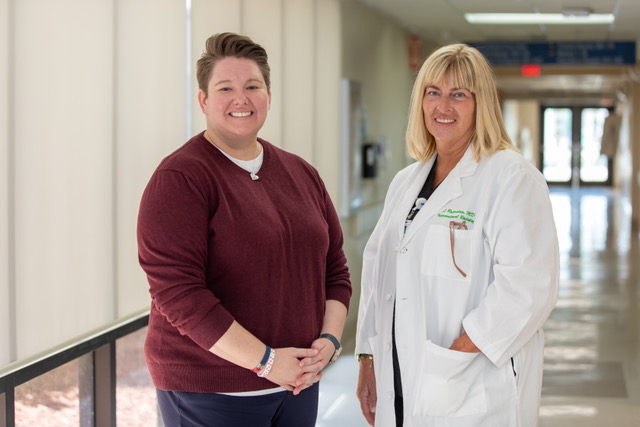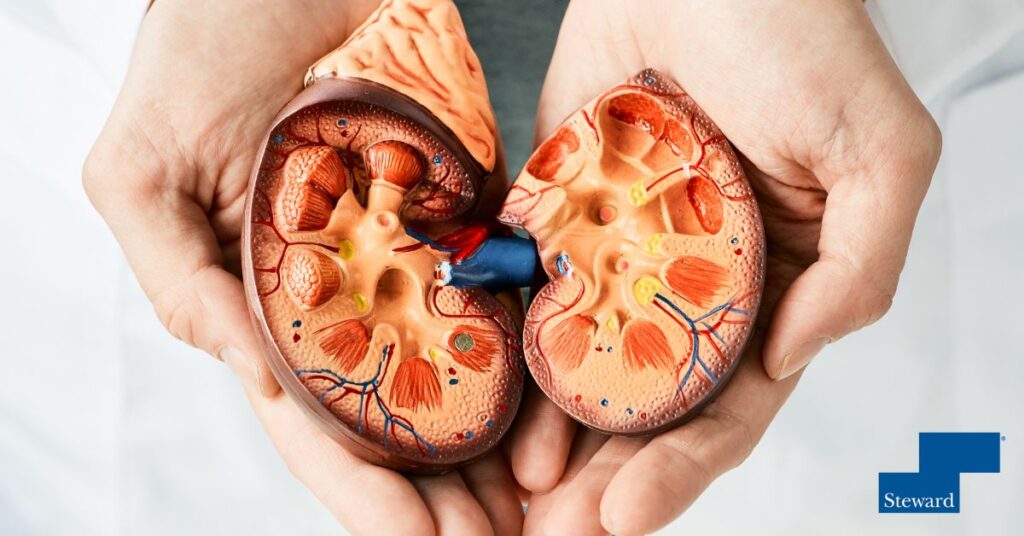Lindsay Tucker, a patient of Sebastian River Medical Center, recalls the day she entered the emergency department and vividly remembers the words of Lisa Rubenstein, MD, interventional radiologist: “Your heart is under a lot of strain and now we need to get those clots out of there.”
“Dr. Rubenstein was unwavering,” described Lindsay. “She was calm. She was assuming. She wanted to answer all my questions because I needed to have surgery and needed to have it now. It’s not something they were going to schedule at another time.”
According to Dr. Rubenstein, the patient had a pulmonary embolus, which is a thrombus, or often referred to as a blood clot, in her lungs blocking the flow of blood so nothing could be “oxygenated.”
“They (Lindsay and her partner) were waiting for me in the room, and I went up to talk with them about the case. They immediately said, ‘Let’s do it. It makes sense,’ “said Dr. Rubenstein. “When I do these procedures, I go either through the neck or through the groin. I take a large catheter and I go directly to the clot. I break it up and pull it out. So not only does it relieve their clot burden, but it allows the lungs to be oxygenated immediately. It’s so exciting to see our patient get better from one second to the next as you pull the clots out.”
Dr. Rubenstein is referring to a procedure that utilizes the Inari ClotTriever and FlowTriever Systems, valuable new options in the interventional toolbox. Blood clots, always a danger particularly for those who have been hospitalized or inactive, have been increasing in size and number during the pandemic. “We see blood clot complications related to the pandemic with both patients who have had Covid and those who haven’t,” says Dr. Rubenstein. “Clots for people who haven’t had COVID can happen because they were staying inside. People aren’t getting out much and most people weren’t very active.
Former treatments normally included blood thinners such as heparin or warfarin, but larger clots require stronger thinners called thrombolytics. Thrombolytics are medicines that may be used for the emergency treatment of an ischemic stroke (a stroke closed by a blood clot), a heart attack (myocardial infarction), or a massive pulmonary embolism (PE). They may also be used for other indications. Thrombolytics carry the risk of serious or fatal bleeding. There are also invasive surgical methods to treat clots.
Sebastian River Hospital has quicker and less invasive treatments through the Inari FlowTriever for pulmonary embolism (PE) and the ClotTriever System for deep vein thrombosis (DVT). Each is a non-surgical option that greatly reduces the risk of bleeding and can shorten a patient’s hospital stay.
“Before introducing these new devices, in the past, patients with large blockages or clots may have had to miss work for one or two months while the blood thinners were working. Now most patients can go back to work in about a week, depending on how sick they are,” explains Dr. Rubenstein.
FlowTriever is the first Food & Drug Administration (FDA) approved mechanical thrombectomy device designed to treat a pulmonary embolism, a clot in a pulmonary artery leading to the lungs. If the clot breaks free and travels to the lungs, it can cause death in almost one-third of all patients.
“At Sebastian River Medical Center, we are committed to investing in cutting-edge technology to support our physicians and surgeons in their efforts to bring our patients the very best care,” says Ron Bierman, Chief Administrative Officer, Sebastian River Medical Center. “We are pleased to be able to offer these clot removal devices that have been real game-changers for our interventional radiologist and our cardiologists.”
Using FlowTriever and ClotTriever for the treatment of deep vein thrombosis, doctors can quickly intervene when patients are at risk. Both devices can treat a patient with one use.
Dr. Rubenstein says the device threads a catheter through a vein to the site of the clot. Suction is then used to pull the clot out of the vessel and from the body. Overall, it helps patients avoid open chest surgery, drugs that might increase bleeding risk and intensive care stays. Symptoms of blood clots include swelling and redness, particularly if it’s just on one side; sharpness in the lungs; and painful breathing. If you experience any of these symptoms, Dr. Rubenstein says go to the emergency room immediately.
The Inari literature and website state that the Inari Medical ClotTriever Thrombectomy System is uniquely designed to core, collect, and extract large venous clots in a single session without the need for thrombolytic drugs or consequent ICU stay. “This self-contained, over the wire system does not require any capital equipment. It is comprised of two components: the ClotTriever catheter, which features a nitinol coring element and mesh collection bag to core and collect clot from the vessel wall and the ClotTriever sheath, which contains an active hemostasis valve, and a large-bore side-port for rapid aspiration and self-explaining nitinol mesh funnel to maximize clot retrieval.”
According to the Inari website, “The Inari Medical FlowTriever® is the first and only mechanical thrombectomy system indicator for treatment of pulmonary embolism uniquely designed to engage, disrupt, and extract venous clots.
Lindsay’s procedure was a success. “Dr. Rubenstein worked for five hours to remove as many clots as she could,” said Lindsay. “Dr. Rubenstein was watching very carefully to see that I got the perfusion back to both of my lungs and gave me the best shot at full recovery. Today I’m doing quite well.”
Lindsay was working on her doctorate degree. It was set to finish just about the time she ended up in the hospital and she was scheduled to defend her doctorate degree the following week. She only had to push it back slightly. “We scheduled my defense the last possible week I could do it – about six weeks after I was released from the hospital, and I was able to successfully defend and then graduate in December. It does feel like a whole new lease on life,” said Lindsay.
Lindsay was thankful that she is now able to exercise, work and live with just very mild symptoms, “I know it’s all because of Dr. Rubenstein and the procedure that she did,” conveyed Lindsay.
“It is so rewarding to see Lindsay up and around, doing exercise and back in classes. It’s again why we went into it. It’s the full reason,” expressed Dr. Rubenstein.
Lindsay recalls a scary moment with thankfulness: “The staff at Sebastian River Medical Center was absolutely incredible. From the moment I walked into the door until the time that I was discharged and got in the car to leave. Every single person I came into contact with was amazing. I don’t think I could have received better care.”
To find a doctor or schedule an appointment, visit Steward DoctorFinder™.




